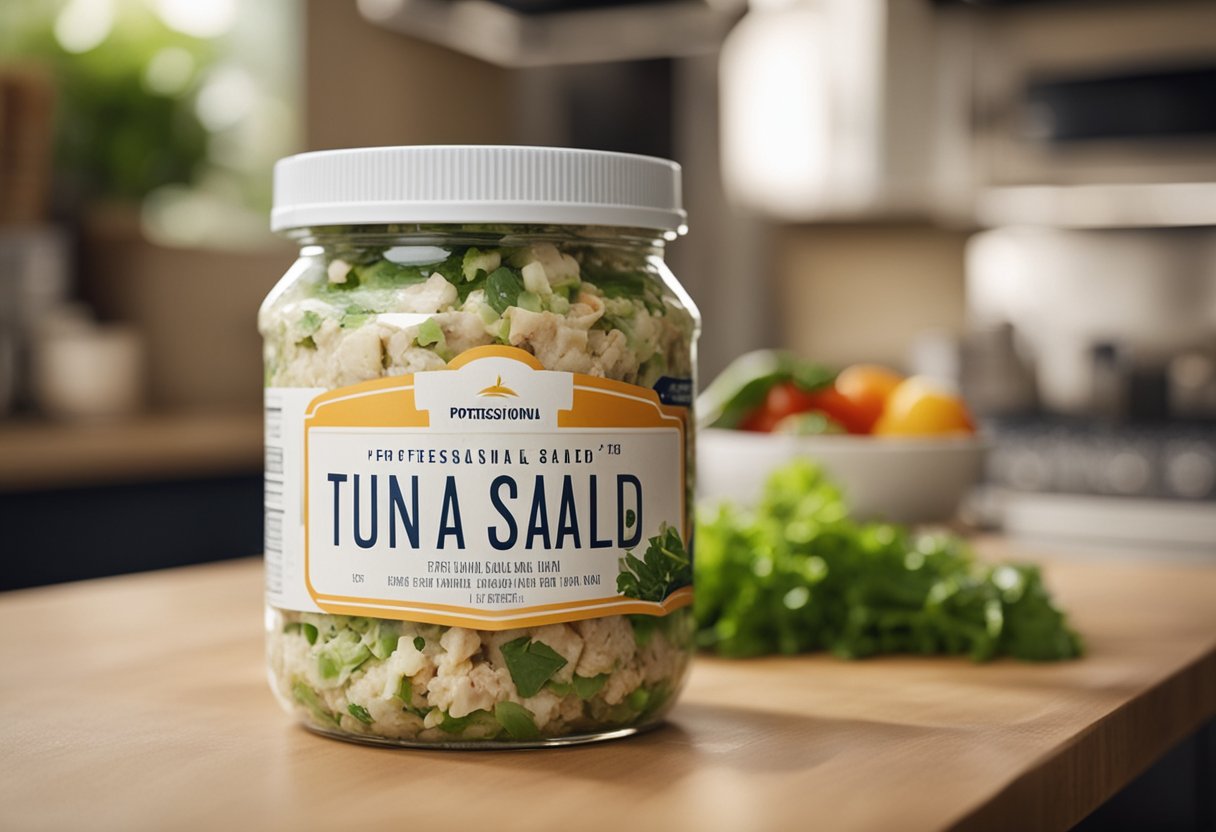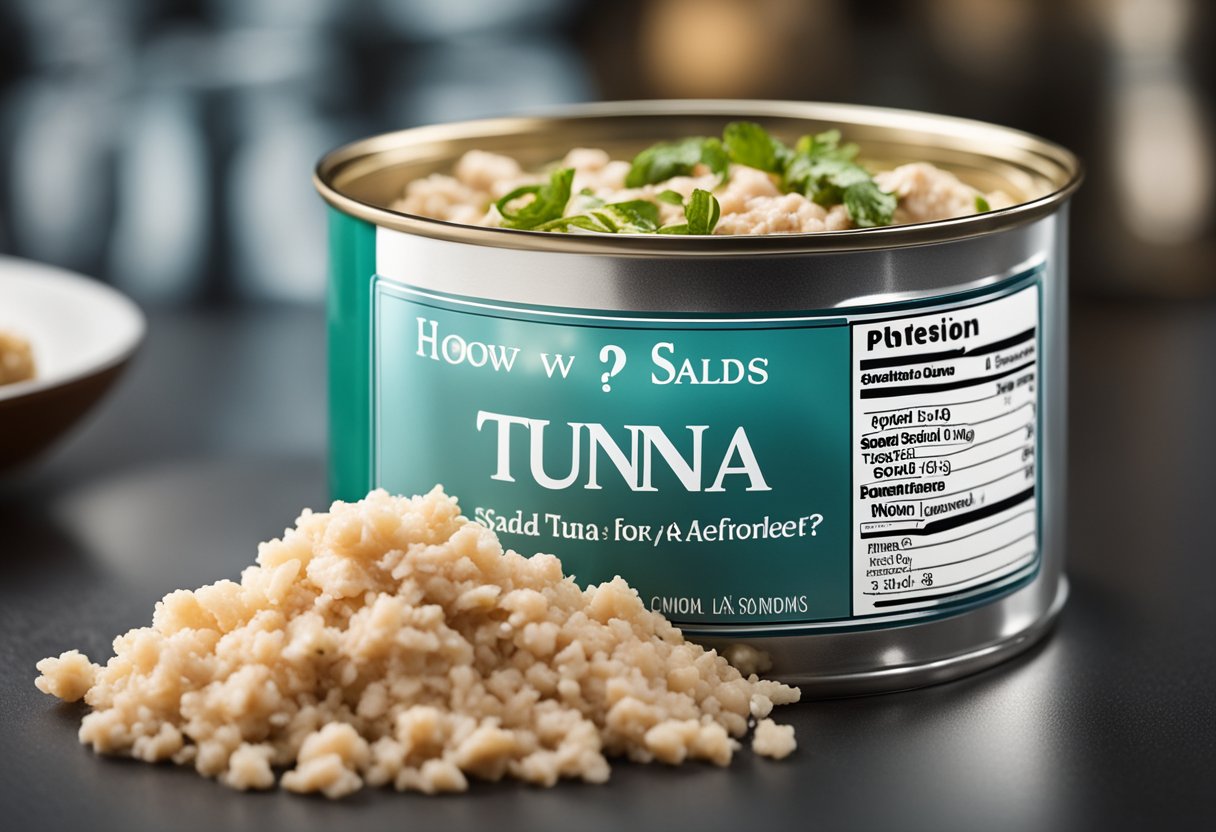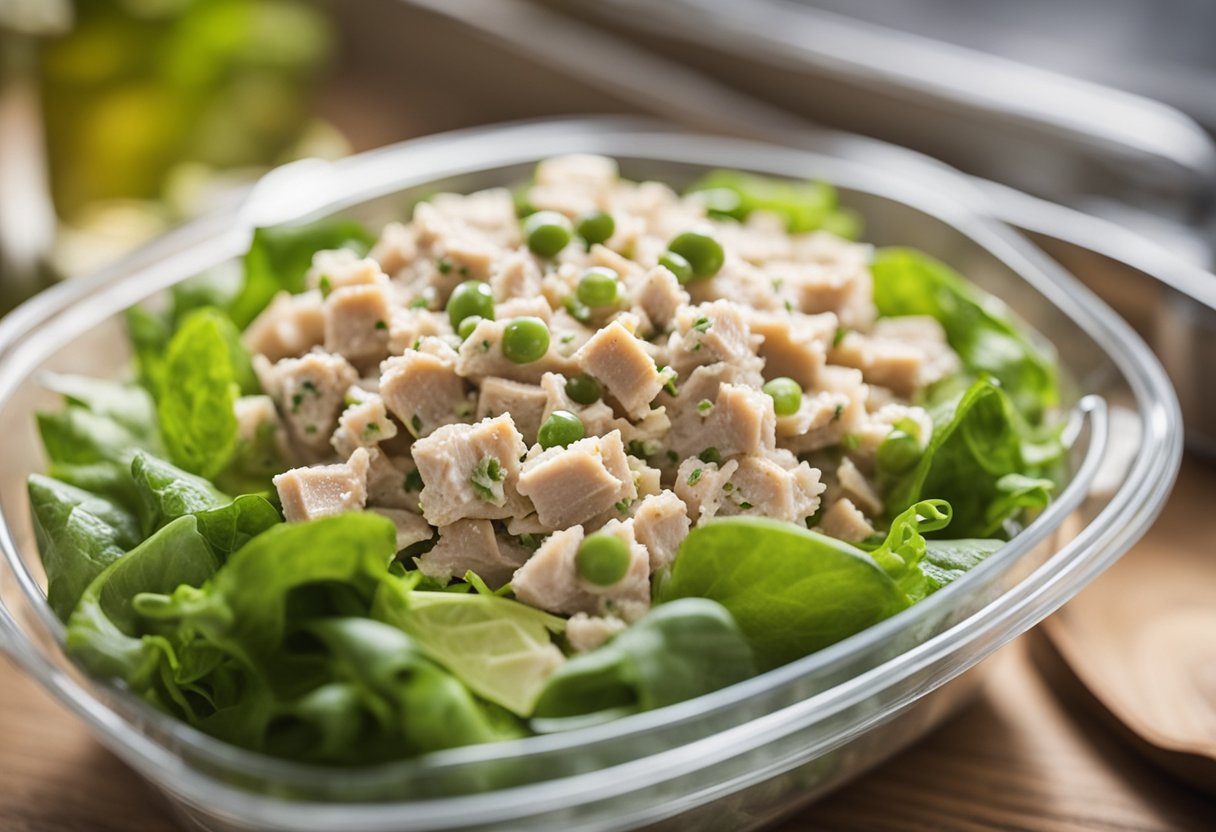As someone who enjoys tuna salad, it’s important to know how long it can be safely stored in the fridge.
Tuna salad is a popular dish that can be made in a variety of ways, but it’s important to understand how to properly store it to avoid foodborne illness.
In this article, I will provide information on how long tuna salad is good for, how to properly store it, and how to identify spoilage.

Tuna salad can be a delicious and healthy meal option, but it’s important to keep in mind that it has a limited shelf life.
Depending on how it’s prepared and stored, tuna salad can last anywhere from three to five days in the fridge.
It’s important to keep the temperature of the fridge at or below 40°F to prevent bacteria growth and spoilage. Additionally, homemade tuna salad may not last as long as store-bought versions due to the lack of preservatives.
Key Takeaways
- Tuna salad can last anywhere from three to five days in the fridge.
- Keep the temperature of the fridge at or below 40°F to prevent spoilage.
- Homemade tuna salad may not last as long as store-bought versions due to the lack of preservatives.
Understanding Tuna Salad

As someone who enjoys tuna salad, it’s important to understand what it is and how it’s made. Tuna salad is a type of salad that is typically made with canned tuna, mayonnaise, and other ingredients.
It can be served on its own, as a sandwich filling, or as a topping for crackers or vegetables.
When making homemade tuna salad, there are many ingredients that can be added to enhance the flavor and texture.
Some common ingredients include celery, onion, red onion, Dijon mustard, lemon juice, and relish. Other ingredients that can be used to add flavor include apple, curry powder, hummus, and various spices.
One of the most important ingredients in tuna salad is the mayonnaise. It is what gives the salad its creamy texture and rich flavor.
When making homemade tuna salad, it’s important to use a high-quality mayonnaise to ensure the best results.
Fresh tuna can also be used in tuna salad, but it requires a bit more preparation. The tuna needs to be cooked and then flaked before it can be added to the salad.
Hard-boiled eggs, chickpeas, and Greek yogurt are other ingredients that can be added to tuna salad to make it more filling and nutritious.
For those who are watching their calorie intake, there are many ways to make a lighter version of tuna salad.
One option is to use avocado instead of mayonnaise. Another option is to serve the tuna salad in a lettuce wrap instead of on bread.
Storing Tuna Salad

As someone who enjoys tuna salad, it’s important to know how to properly store it to ensure it stays fresh for as long as possible. The key to storing tuna salad is to keep it refrigerated in an airtight container.
If you’re making homemade tuna salad, it’s best to refrigerate it within two hours of making it. This will help prevent bacterial growth and keep it fresh for longer.
When storing it in the fridge, make sure it’s in an airtight container to prevent any air from getting in and causing it to spoil faster.
For store-prepared tuna salad, it’s important to check the expiration date before purchasing it.
Once you’ve opened the container, make sure to transfer it to an airtight container and refrigerate it immediately. It’s best to consume store-prepared tuna salad within 3 to 5 days after opening.
It’s also important to note that tuna salad should never be left out at room temperature for more than two hours. This can cause bacterial growth and make it unsafe to consume.
Overall, storing tuna salad properly is crucial to ensure it stays fresh and safe to eat. By refrigerating it in an airtight container and consuming it within the recommended time frame, you can enjoy your tuna salad without any worries.
Temperature and Tuna Salad

As with any food, temperature plays a crucial role in determining how long tuna salad can be safely stored.
Tuna salad should always be stored at the right temperature to avoid bacterial growth, which can lead to foodborne illness.
The ideal temperature for storing tuna salad is below 40°F (4°C). This means that it should be stored in the refrigerator as soon as possible after preparation.
If left at room temperature for more than two hours, tuna salad can become a breeding ground for bacteria, especially in temperatures between 40°F (4°C) and 140°F (60°C), known as the “danger zone”.
It is important to note that the longer tuna salad is left at room temperature, the greater the risk of bacterial growth.
Therefore, if you plan to consume tuna salad later in the day, it is best to keep it in a cooler with ice packs until you are ready to eat it.
When storing tuna salad in the refrigerator, it is important to keep it in an airtight container to prevent contamination from other foods.
Homemade or store-prepared tuna salad can last 3 to 5 days in the refrigerator if properly stored in an airtight container within two hours of preparing or purchasing.
In summary, tuna salad should always be stored at the right temperature to avoid bacterial growth. It should be kept in the refrigerator below 40°F (4°C) and consumed within 3 to 5 days if properly stored.
If left at room temperature for more than two hours, it can become a breeding ground for bacteria, especially in temperatures between 40°F (4°C) and 140°F (60°C), known as the “danger zone”.
Freezing and Defrosting Tuna Salad
Freezing Tuna Salad
As mentioned earlier, tuna salad can last up to 3 to 5 days in the refrigerator. However, if you have leftovers or want to prepare tuna salad in advance, you can freeze it.
Freezing tuna salad is a great option to extend its shelf life. When properly stored, tuna salad can have a shelf life of up to 2 months.
Before freezing tuna salad, it’s important to note that creamier salads shouldn’t be frozen because the mayo separates due to freezing, and the dish’s quality is sacrificed.
Therefore, it’s best to freeze low-mayonnaise tuna salad recipes.
Here are the steps to freeze tuna salad:
- Place the tuna salad in an airtight container or a freezer-safe plastic bag. Make sure to remove any excess air from the container or bag before sealing it.
- Label the container or bag with the date you freeze it.
- Place the container or bag in the freezer.
Defrosting Tuna Salad
When it’s time to defrost the tuna salad, it’s important to do it properly to maintain its taste and texture. Here are the steps to defrost tuna salad:
- Remove the tuna salad from the freezer and place it in the refrigerator.
- Allow the tuna salad to defrost in the refrigerator for a few hours or overnight.
- Once the tuna salad is defrosted, give it a good stir to redistribute any liquids that may have separated.
- Check the tuna salad’s texture and taste. If it’s still good, you can consume it. If it looks or smells off, it’s best to discard it.
It’s important to note that once you defrost tuna salad, you shouldn’t refreeze it. Doing so can cause bacteria to grow, which can lead to food poisoning.
Therefore, it’s best to only defrost the amount of tuna salad you plan to consume.
Overall, freezing tuna salad is a great way to extend its shelf life. Just make sure to follow the proper steps to ensure that the tuna salad stays fresh and safe to eat.
Identifying Spoilage in Tuna Salad

As with any food, tuna salad can spoil if it is not stored properly or consumed within a certain timeframe.
It is important to be able to identify signs of spoilage to avoid getting sick from consuming bad tuna salad.
One of the main culprits of spoilage in tuna salad is bacteria. Bacteria can grow rapidly in moist environments, especially if the temperature is above 40°F.
If tuna salad has been left out at room temperature for more than two hours, it should be discarded.
Additionally, if tuna salad has been stored in the refrigerator for more than five days, it is best to err on the side of caution and throw it away.
Another common cause of spoilage in tuna salad is mold. If you notice any mold growing on the surface of the tuna salad, it should be discarded immediately.
Mold can produce toxins that can make you sick, so it is important to avoid consuming any food that has mold growing on it.
One way to identify spoilage in tuna salad is by its appearance. If the tuna salad looks slimy or has a discolored appearance, it is likely spoiled.
Additionally, if the tuna salad has a sour or off odor, it should be discarded. These are all signs that the tuna salad has gone bad and should not be consumed.
In summary, it is important to properly store tuna salad and consume it within a reasonable timeframe to avoid spoilage.
Signs of spoilage include the presence of bacteria or mold, a slimy or discolored appearance, and an off odor. If you notice any of these signs, it is best to discard the tuna salad to avoid getting sick.
Health and Safety Considerations

As a food product, tuna salad has a limited shelf life and requires proper storage to maintain its quality and safety.
As such, it is important to consider health and safety considerations when preparing, storing, and consuming tuna salad.
One of the primary concerns when it comes to tuna salad is the risk of food poisoning. This can be caused by bacterial growth, which can occur when the salad is not stored at the proper temperature or is left out at room temperature for too long.
To reduce the risk of foodborne illness, it is important to store tuna salad in the refrigerator at a temperature below 40°F (4°C) and to discard any salad that has been left out at room temperature for more than two hours.
Another potential health concern when it comes to tuna salad is scombroid poisoning. This is caused by consuming fish that has not been properly stored and has begun to spoil.
Symptoms of scombroid poisoning can include headache, flushing, and gastrointestinal distress.
To reduce the risk of scombroid poisoning, it is important to ensure that the tuna used in the salad is fresh and has been properly stored.
To ensure the safety and quality of tuna salad, it is important to follow the guidelines set forth by the United States Department of Agriculture (USDA) for food safety. This includes proper storage, handling, and preparation techniques.
Additionally, it is important to pay attention to the expiration date of any ingredients used in the salad, such as mayonnaise or canned tuna.
In summary, when preparing and consuming tuna salad, it is important to consider health and safety considerations to reduce the risk of foodborne illness.
This includes proper storage, handling, and preparation techniques, as well as paying attention to expiration dates and the freshness of ingredients.
By following these guidelines, you can enjoy tuna salad safely and with peace of mind.
Tuna Salad Variations

I love tuna salad because it is such a versatile dish that can be customized to suit different tastes and preferences. Here are some variations that you can try:
- Sandwiches: Tuna salad is a classic sandwich filling that can be enjoyed on its own or with other ingredients like lettuce, tomato, and cheese. You can use any type of bread, from whole wheat to sourdough, and add condiments like mayonnaise, mustard, or relish.
- Texture: The texture of tuna salad can be varied by adding different ingredients. For a chunkier salad, use canned tuna in water and leave some larger pieces intact. For a creamier salad, add more mayonnaise or Greek yogurt. You can also add diced celery, onion, or pickle for extra crunch.
- Lettuce wrap: If you’re watching your carb intake, try using lettuce leaves instead of bread to wrap your tuna salad. This is a great option for a light lunch or snack.
- Dip: Tuna salad can also be used as a dip for vegetables or crackers. To make a dip, simply add more mayonnaise or Greek yogurt until the mixture is smooth and creamy.
- potato chips: For a fun twist, serve your tuna salad with potato chips instead of bread. The salty crunch of the chips pairs well with the creamy tuna salad.
- Variations: Tuna salad can be customized in many different ways. Try adding different spices like curry powder or cumin, or swapping out the tuna for other proteins like chicken or hard-boiled eggs.
- Cucumbers: For a refreshing summer salad, try serving your tuna salad on top of sliced cucumbers. This is a great option for a light lunch or appetizer.
- Chicken salad: If you prefer chicken to tuna, you can easily swap out the protein in this recipe. Simply substitute canned chicken for the tuna and follow the same instructions.
- Egg salad: Similarly, you can also make an egg salad by substituting hard-boiled eggs for the tuna. Add mayonnaise, mustard, salt, and pepper to taste.
Overall, tuna salad is a delicious and versatile dish that can be customized to suit any taste or occasion. Whether you prefer it on a sandwich or as a dip, there are endless variations to try.
Nutritional Value of Tuna Salad

As a seafood, tuna is a great source of protein and omega-3 fatty acids. Tuna salad, a popular dish made from canned tuna, is a convenient and tasty way to enjoy these nutritional benefits.
A typical serving of tuna salad contains around 383.3 calories, 19.3g of net carbs, 19g of fat, and 32.9g of protein.
However, the exact nutritional content can vary depending on the specific recipe and ingredients used.
The protein in tuna salad is essential for building and repairing tissues in the body.
Additionally, the omega-3 fatty acids found in tuna can provide numerous health benefits, such as reducing inflammation and improving heart health.
It’s important to note that the nutritional value of tuna salad can be affected by the type and amount of dressing used.
For a healthier option, consider using light mayonnaise or a vinaigrette dressing instead of traditional mayonnaise.
Overall, tuna salad can be a nutritious and delicious addition to a balanced diet.
Related Salads
As a lover of salads, I am always on the lookout for new recipes to try. While tuna salad is a classic favorite, there are other salads that are equally delicious and worth trying.
In this section, I will discuss some related salads to tuna salad and provide some tips for making and storing them.
Potato Salad
Potato salad is a popular salad that is perfect for picnics, barbecues, and potlucks. It is made with boiled potatoes, mayonnaise, and other ingredients such as chopped onions, celery, and pickles.
Some recipes also include hard-boiled eggs, bacon, and mustard.
When it comes to storing potato salad, it is important to keep it refrigerated and consume it within 3 to 5 days. To prevent the salad from getting watery, it is best to add the dressing just before serving.
Chicken Salad
Chicken salad is another popular salad that is perfect for lunch or dinner. It is made with cooked chicken, mayonnaise, and other ingredients such as celery, onions, and grapes.
Some recipes also include nuts, such as almonds or pecans, for added crunch.
When it comes to storing chicken salad, it is important to keep it refrigerated and consume it within 3 to 4 days. To prevent the salad from getting dry, it is best to add the dressing just before serving.
Egg Salad
Egg salad is a simple and delicious salad that is perfect for breakfast, lunch, or dinner. It is made with hard-boiled eggs, mayonnaise, and other ingredients such as chopped celery, onions, and pickles.
Some recipes also include mustard and paprika for added flavor.
When it comes to storing egg salad, it is important to keep it refrigerated and consume it within 3 to 5 days. To prevent the salad from getting watery, it is best to add the dressing just before serving.
Overall, these related salads are perfect for any occasion and are easy to make. Just remember to store them properly and consume them within the recommended time frame to ensure freshness and safety.
Frequently Asked Questions
How long is tuna salad good for in the fridge?
Tuna salad can last for 3-5 days in the fridge if stored in an airtight container within two hours of preparing or purchasing. 1
It is important to keep it refrigerated and not let it get too warm. If you are unsure whether the tuna salad is still good, it is best to discard it.
How long can you keep tuna mayo mix?
Tuna mayo mix can last for 3-5 days in the fridge if stored in an airtight container within two hours of preparing or purchasing. 2
It is important to keep it refrigerated and not let it get too warm. If you notice any signs of spoilage, such as a sour smell or slimy texture, it is best to discard it.
What are the signs that tuna salad has gone bad?
The signs that tuna salad has gone bad include a sour smell, slimy texture, or discoloration. 3 If you notice any of these signs, it is best to discard the tuna salad.
How long does tuna salad last in the freezer?
Tuna salad can be stored in the freezer for up to 2 months. 4 It is important to store it in an airtight container or freezer bag to prevent freezer burn.
How long is a tuna sandwich good for at room temperature?
A tuna sandwich should not be left at room temperature for more than 2 hours. 5 After that, bacteria can grow rapidly, and the sandwich should be discarded.
Can you eat tuna salad after a week?
It is not recommended to eat tuna salad after a week, even if it has been stored in the fridge. 1 It is best to consume it within 3-5 days of preparation or purchase to ensure freshness and safety.
Footnotes







